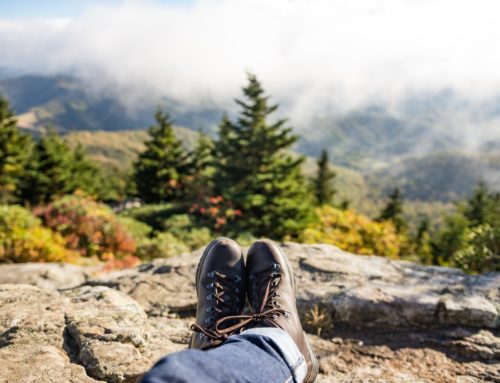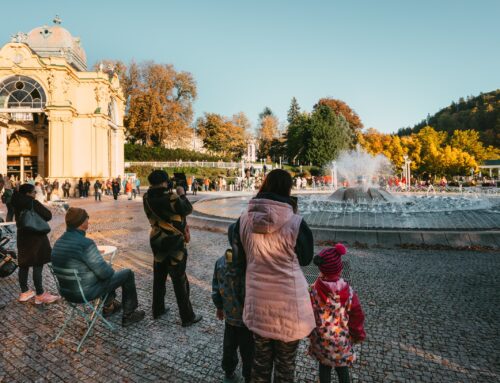Mariánské Lázně. A town that needs no introduction. Most of us immediately think of the Singing Fountain, the colonnade with springs, the bogs or the Boheminium Park. But did you know that the surrounding forests and groves also hide many other interesting things? Let’s discover together the hidden treasures around Mariánské Lázně. There’s definitely a lot to discover and admire!
Bohemian Iceland in the middle of the forests
Mineral springs and their wild spouts, forest ponds, mountain peat bogs or deep forests. The surroundings of Mariánské Lázně will surprise you with their beauty and desolation at the same time. When you have had your fill of relaxing with beneficial treatments, start exploring the surroundings. We recommend choosing the village of Kladská as the starting point of your trip. The hunting lodge and several other Swiss-style buildings create a unique atmosphere, which is complemented by the surrounding forest ponds and a nature trail leading around the ponds and peat bogs. In short, Kladská and its surroundings are the pearl of the Slavkov Forest.
The history of Kladská dates back to 1875, when Prince Schönburg-Waldenburg, enchanted by the beauty of the local nature, founded it as a hunting village. Nowadays, the Kladská Peatlands nature trail attracts most people to Kladská. A circular route of about two and a half kilometres leads from Kladská past the Kladský Pond through the largest of the eight local peat bogs, the Tajga, and along the dike between the Dolní and Horní Bahňák ponds back to Kladská.
The trail has a total of eight stops, and you can read on the information boards many interesting facts about the local forests and the wildlife that inhabits them, the peat bogs, mineral springs and mining activities in the Slavkovský Forest area. The bogs and peat bogs are crossed by a trail through the boggy paths, and it is safe for mothers with prams and wheelchair users.
In addition to natural beauty and attractions, Kladská offers other attractions. There is a sundial right on the nature trail, where you can compare the time on your watch (or phone) with the time on the sun. It is interesting in that you measure the time on it with your own shadow, as the local clock does not have a gnomon, but a wooden board on the ground on which you have to stand.
Another interesting feature of Kladsko is the statue of the Dying Deer, created in 1964 from ceramics by the Moravian sculptor Antonín Kalvoda. It impresses mainly because of its unusual colouring, which is said to have been created by the artists breaking beer bottles against the statue during firing. It is probably not true, but it is a nice legend.
You can stay in one of the guesthouses in Kladská, and there is also an information centre, a car park and a restaurant.

The origin of the crosses is shrouded in mystery
Not far from Kladská you will find a national nature reserve that you cannot miss – the Crosses in Slavkovský les (Slavkov Forest). To the right of the road connecting Prameny with Nová Ves, there are three crosses on a rocky hill. However, the reserve is unique for naturalists in that a number of rare species of plants and lichens grow here in a relatively small area.
The crosses offer a breathtaking spectacle all year round. The colourful flora makes them burst with colour. In spring, they are covered with pink flowering pillows of the rare heather, in summer, arnica blooms here, which has become part of the emblem of the Slavkov Forest Protected Landscape Area itself, and autumn belongs to the purple flowers of heather and the red leaves of the cottonwood.
Magical, beautiful, enchanting. The origins of the three crosses that rise to the sky above the reserve itself are somewhat shrouded in mystery. According to one legend, the crosses were erected in 1849 by three brothers from nearby Sanderberg (today’s Prameny) as a thank you for healing them from a serious illness. We don’t know how it really happened, because the original German population was displaced after 1945 and the whole area became a military zone for several years.
It is a wonder that the unmissable crosses of the army’s farming survived. The then small town of Sanderberg, which had a population of around two thousand, has changed beyond recognition. The church of St. Linhart and the monumental tomb of Adam Tanzer in the local cemetery have been taken for dead. In 1967, the local national committee had it dismantled and sold off the stone blocks.
The ever-increasing popularity of the Crosses (Křížky) of the Slavkov Forest is evidenced by the number of travellers you meet here. As there are so many rare species of plants and lichens here, it is all the more important to stick to the marked paths and behave in accordance with the rules of the nature reserve.

Domin rock formation (Dominova skalka)
The area around Křížky, and in general the whole area between Prameny and Mnichov, is one of the most remarkable areas of the Slavkov Forest. In addition to the Crosses, you will find another natural monument here, the Dominova skalka. It bears the name of the important botanist and author of a phytogeographical study on the flora of the Slavkov Forest, Professor Karel Domino.
The subject of protection are serpentinite rocks, otherwise known as serpentine rocks, on which grow the heather, the endemic curly-leaved hornwort, the critically endangered Sudeten creeper and other species. This rock is very poor in nutrients and is therefore difficult and slow to weather. Due to its high magnesium content, it then leaches into the surrounding soil and, together with other elements, forms a specific substrate that significantly influences the vegetation cover. So if you like rockeries, Domino’s rockery is not to be missed.

When the unique comes out of the ground
A stone’s throw away, just 6 kilometres from Křížky, you will find a unique mineral spring, known as Grünská kyselka (Grün mineral water), in the vicinity of the village of Louky. Since until the Second World War it was mostly German-speaking people who lived here, the village itself was then called Grün. It is therefore clear where the name comes from.
After the war, the place became deserted. It was not revived until 1990, when Karlovy Vary Mineral Waters started its bottling plant and restored the local natural spring, which has the highest magnesium content in the world. So you can tap and enjoy a delicious mineral water for free.
And what makes this mineral water so unique? It is the aforementioned rare rock, through which water from the deep rushes to the surface. The snake got its name because its appearance resembles the skin of a snake. Snake rock itself is extremely magnesian. They are almost nowhere to be found on the Earth’s surface, at home in the Earth’s mantle. So deep, where man can never look. And that’s why there are so few places where snakeweed reaches the Earth’s surface. The presence of snakes in the Slavkov Forest proves that the ocean once expanded here long ago. Who wouldn’t want to taste a mineral water gift straight from the depths of the Earth?

The Forgotten Dřevohryzy
Dřevohryzská kyselka (Dřevohryzská mineral water) can compete with the aforementioned friend only with its strength. Not far from the village of Dobrá Voda, near the extinct village of Dřevohryzy, you will come across a spring that is part of the experience route “Vidžín – Telecí potok – Dřevohryzská kyselka”. Before World War II, the village of Dřevohryzy had almost 160 inhabitants, today it is just an overgrown plain. The only evidence of the former settlement are the uneven terrain, mature trees and a modest remnant of a road.
However, the Dřevohryz acid spring is still here. It was cleaned, restored and made accessible in 2012. The acid is now captured in a wooden segmented barrel and is covered by a wooden gazebo in the traditional acid colour. The access road has also been improved and a wooden footbridge leads across part of the extensive marsh and marshy meadow that surrounds the gazebo. So you don’t have to worry about getting here dry-footed.
The combination of old and new
Finally, we present a truly extraordinary work. In the forests between Toužimí and Teplá lies one of the greatest jewels of contemporary architecture – Nový Dvůr Abbey. The author of the monastery of the Mother of God in Nový Dvůr near Dobrá Voda, neglected by the laity but considered by experts to be a European unique, is the famous minimalist architect John Pawson. Away from the hustle and bustle of civilisation, the monastic community of the Trappist Order lives here, surrounded by modern design combined with a masterfully reconstructed Baroque farmhouse under the baton of Jan Soukup, a Pilsen-based architect who is an expert in the reconstruction of historical buildings.
The site has a remarkable architectural history. The Baroque court was plundered in the 1950s by the socialist “yeshiva”. The construction of the new monastery, which combines new and old elements, is a kind of bridge between the past and the future. The minimalist architecture emphasises the simple monastic life, while being enriched by glimpses into the changing images of the surrounding landscape.
Visitors can visit the monastery church, which features twenty shades of white and no other colour, seven times a day. Anyone can attend the prayers of the twenty or so monks here. But it is important to maintain restraint and consideration. You can also visit the visitors’ house, where you can watch a film about the life of the monks and see a small exhibition related to it. You can finish your journey in the monastery shop, where you can buy some of the Order’s products, such as the renowned excellent French mustard and various jams.
As is quite evident, there are many hidden treasures in the surroundings of Marienbad. Some of them can be seen from afar, others have to be quietly searched for. However, this does not change the fact that it would be a great pity to stay only in the centre of the famous spa town.





